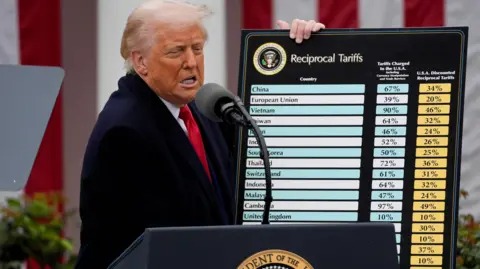The Donald Trump administration has imposed sweeping tariffs on imports, invoking the International Emergency Economic Powers Act (IEEPA) as justification Tariff News. The Washington Post+3JURIST+3Reuters+3
On 5 November 2025 the Supreme Court of the United States heard arguments about whether the President has the authority under IEEPA to impose broad tariffs without explicit congressional approval.
During the hearing, justices from across the ideological spectrum expressed skepticism about the administration’s interpretation of IEEPA. Chief Justice John Roberts questioned whether tariffs are properly an “emergency” regulatory power.
AP News
The administration argued the tariffs are regulatory in nature (aimed at adjusting trade balance and protecting domestic industry), not merely revenue‑raising. The Washington Post
If the court rules against the administration, several key implications follow:
-
The tariffs might be invalidated or require refunding of previously paid duties. The Washington Post
-
It may significantly limit executive power in trade policy.
-
It could trigger further trade volatility as businesses adjust expectations.
Economic & Trade Impact
The tariff increases have significant global repercussions. For example, the Organisation for Economic Co‑operation and Development (OECD) warned that higher U.S. import tariffs will slow growth and raise inflation globally. mint+1
Key points:
-
The OECD said that a 10 percentage‑point tariff increase could reduce global output by 0.3 % by 2026. mint
-
Trade volumes are projected to slow: the International Monetary Fund (IMF) expects global trade (goods + services) to grow 3.6 % in 2025, slowing to ~2.3 % in 2026. The Economic Times
-
Many firms face direct costs from tariffs: global companies have reported over US$35 billion in cost hit due to U.S. tariffs. News24
-
Supply chains are being re‑shaped, as seen in companies shifting manufacturing away from China to avoid tariff risks. The Australian+1
Why It Matters
Tariffs affect economies in three major ways:
-
Costs – Import duties raise costs for businesses that rely on foreign inputs; these costs often get passed on to consumers.
-
Investment & growth – Trade uncertainty dampens business confidence, leading to lower investment and slower growth. The Economic Times+1
-
Policy & geopolitics – Trade policy is increasingly tied to geopolitical strategy (e.g., manufacturing relocation, trade blocs), which adds an extra layer of risk and complexity.
Pakistan’s Context
For Pakistan, the tariff landscape presents both challenges and opportunities.
Tariff Reform & IMF Agreement
Pakistan has agreed with the IMF to substantially cut its average applied tariffs. Specifically, the average weighted tariff is to be reduced from ~10.6 % to about 6 % over five years. Business Standard+1
This trade liberalisation is meant to open up the economy, boost export competitiveness, especially in sectors like autos and minerals. Profit by Pakistan Today
External Risks
At the same time, Pakistan faces external risks:
-
The U.S. critique of Pakistan’s trade practices: a recent report raised concerns over high tariffs and non‑tariff barriers in Pakistan. Business Recorder
-
The U.S. has levied or threatened “reciprocal” tariffs on certain countries (including Pakistan) in its broader tariff strategy. Arab News PK+1
-
While lower tariffs may boost long‑term growth, in the short‑term Pakistan could face revenue impacts and increased import competition.
Implications for Pakistan
-
If global trade slows, export growth could be constrained. Pakistan must diversify export markets and upgrade competitiveness.
-
Reduced tariffs mean domestic industries will face greater foreign competition — pressure to become more efficient.
-
On the positive side, Pakistan may benefit if trade is diverted from countries hit hardest by U.S. tariffs (so-called trade‑diversion). Analysts have flagged mixed impact for Pakistani exports under U.S. tariffs. Arab News PK
-
Pakistan’s supply chain links matter: if global supply chains re‑route (away from China, say), Pakistan could position itself advantageously, if it invests in infrastructure and trade facilitation.
What to Watch Going Forward
Here are key developments to monitor:
-
Supreme Court decision in the U.S. on the legality of the tariff regime under IEEPA. A ruling in favor of limiting executive tariff power would change the global trade policy terrain.
-
Retaliation & trade war escalation. If countries respond with broad counter‑tariffs, global growth may decelerate further, affecting Pakistan’s exports and remittances.
-
Supply chain shifts. Firms redirecting manufacturing (e.g., from China to Southeast Asia/Mexico) could open opportunities for Pakistan — if it can offer competitive cost, logistics and trade facilitation.
-
Pakistan’s tariff reform implementation. The timeline and political commitment to reduce tariffs, and whether accompanying reforms (customs, non‑tariff barriers) proceed.
-
Global demand outlook. With trade growth slowing, Pakistan’s export strategy must emphasise not just access, but value‑addition, new markets, digital/trade services.
-
Domestic industrial policy response. As tariffs fall and competition rises, Pakistan’s industries will need to invest in productivity, technology, exports rather than relying on protection.
Conclusion
The current wave of tariff changes is more than economic policy — it’s reshaping global trade rules, supply chains, and strategic alignment. For Pakistan, there are both headwinds (increased competition, export risks) and opportunities (tariff reform, trade diversion) ahead.
